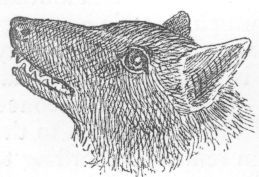| Page 15 | |
|
Natural History of the Mammalia of India and Ceylon - by Robert A. Sterndale F.R.G.S., F.Z.S. (1884) | |
| prev page next page | contents |
GENUS CYNOPTERUS.
This genus has four molars less than the last, a shorter muzzle; the cheek-bones or zygomatic arch more projecting; tongue rather longer and more tapering, and slightly extensile.
Dental formula: Inc., 4/4 or 4/2; can., 1—1/1—1; premolars, 2—2/3—3; molars, 2—2/2—2.
33. CYNOPTERUS MARGINATUS. The Small Fox-Bat (Jerdon's No. 14).
NATIVE NAME.—Chamgadili, Hindi; Coteekan voulha, Singhalese.

|
| Cynopterus marginatus |
HABITAT.—India generally, and Ceylon.
DESCRIPTION.—General colour fulvous olivaceous, paler beneath and with an ashy tinge; ears with a narrow margin of white (Jerdon.) A reddish smear on neck and shoulders of most specimens; membranes dusky brown. Females paler (Kellaart).
SIZE.—Length, 4½ to 5½ inches; extent of wing, 17 to 20 inches.
This bat is found all over India; it is frugivorous exclusively, though some of this sub-order are insectivorous. Blyth says he kept some for several weeks; they would take no notice of the buzz of an insect held to them, but are ravenous eaters of fruit, each devouring its own weight at a meal, voiding its food but little changed whilst slowly munching away; of guava it swallows the juice only. Blyth's prisoners were females, and after a time they attracted a male which hovered about them for some days, roosting near them in a dark staircase; he was also caught, with one of the females who had escaped and joined him. Dr. Dobson writes that in three hours one of these bats devoured twice its own weight. This species usually roosts in trees.
34. MACROGLOSSUS (PTEROPUS) MINIMUS. The Tenasserim Fox-Bat.
NATIVE NAME.—Lowo-assu (dog-bat), Javanese.
HABITAT.—The Himalayas, Burmah, Tenasserim, and the Indian Archipelago.
DESCRIPTION.—Ears half length of head, narrow and rounded at tip; face abruptly narrowed in front of eyes; muzzle long, narrow, cylindrical; lower jaw slightly projecting; eyes large; tongue very long, last third attenuated, covered with brush-like papillæ; interfemoral membrane very narrow, especially at root of tail; fur reddish brown, and very long.
SIZE.—Head and body, 2-3/10 inches.
Like other Pteropi this bat feeds on fruit of every description, but particularly attacks the various cultivated varieties of Eugenia (Jamoon).
GENUS EONYCTERIS.
Muzzle long and cylindrical; nostrils scarcely projecting; upper lip with a shallow vertical groove in front; index finger without a claw; thumb short; part of the terminal phalanx included in the wing membrane; metacarpal bone of the second finger equal to the index finger in length; tail short and distinct; the base contained in the narrow interfemoral membrane; tongue long, as in Macroglossus.
Dentition: Inc., 4/4; can., 1—1/1—1; premolars, 2—2/2—2; molars, 3—3/3—3.
35. EONYCTERIS SPELÆA.
HABITAT.—Burmah.
DESCRIPTION.—Head long; muzzle narrow, cylindrical, abruptly narrowed in front of the eyes; nostrils with an intervening emargination, which also passes down to the lips; tongue very long and pointed; ears conical, with rounded tips; body clothed with very short and thinly-spread fur of a uniform dark brown colour; the fur on the head extends only as far as the inner corners of the eye, leaving the rest of the face naked; tail half an inch. On each side, and a little behind the anal opening, are two small, kidney-shaped subcutaneous glandular bodies.
SIZE.—Head and body, 4 inches; tail, ½ inch.
Found in Farm Caves, Moulmein. The absence of the claw on the index finger is specially to be noted.
